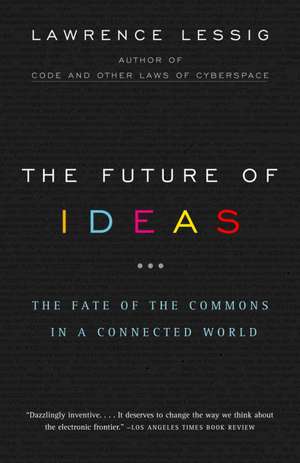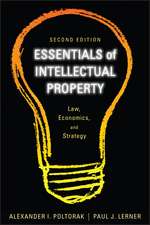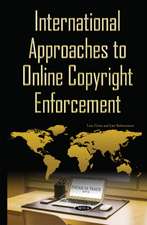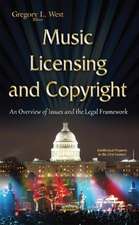The Future of Ideas: The Fate of the Commons in a Connected World
Autor Lawrence Lessigen Limba Engleză Paperback – 30 sep 2002
Lessig weaves the history of technology and its relevant laws to make a lucid and accessible case to protect the sanctity of intellectual freedom. He shows how the door to a future of ideas is being shut just as technology is creating extraordinary possibilities that have implications for all of us. Vital, eloquent, judicious and forthright, The Future of Ideas is a call to arms that we can ill afford to ignore.
Preț: 114.19 lei
Nou
Puncte Express: 171
Preț estimativ în valută:
21.85€ • 22.73$ • 18.04£
21.85€ • 22.73$ • 18.04£
Carte disponibilă
Livrare economică 24 martie-07 aprilie
Preluare comenzi: 021 569.72.76
Specificații
ISBN-13: 9780375726446
ISBN-10: 0375726446
Pagini: 384
Dimensiuni: 135 x 204 x 21 mm
Greutate: 0.29 kg
Editura: Vintage Publishing
Locul publicării:United States
ISBN-10: 0375726446
Pagini: 384
Dimensiuni: 135 x 204 x 21 mm
Greutate: 0.29 kg
Editura: Vintage Publishing
Locul publicării:United States
Notă biografică
Lawrence Lessig is a professor of law at the Stanford Law School. Previously Berkman Professor of Law at Harvard Law School from 1997 to 2000 and professor at the University of Chicago Law School from 1991 to 1997, he is a graduate of the University of Pennsylvania, Trinity College, Cambridge, and Yale Law School. He clerked for Judge Richard Posner on the Seventh Circuit Court of Appeals and Justice Antonin Scalia on the United States Supreme Court. He is a monthly columnist for The Industry Standard, a board member of the Red Hat Center for Open Source, and the author of Code and Other Laws of Cyberspace.
From the Hardcover edition.
From the Hardcover edition.
Extras
Davis Guggenheim is a film director. He has produced a range of movies, some commercial, some not. His passion, like his father’s before, is documentaries, and his most recent, and perhaps best, film, The First Year, is about public school teachers in their first year of teaching–a Hoop Dreams for public education.
In the process of making a film, a director must “clear rights.” A film based on a copyrighted novel must get the permission of the copyright holder. A song in the opening credits requires the rights of the artist performing the song. These are ordinary and reasonable limits on the creative process, made necessary by a system of copyright law. Without such a system, we would not have anything close to the creativity that directors such as Guggenheim have produced.
But what about the stuff that appears in the film incidentally? Posters on a wall in a dorm room, a can of Coke held by the “smoking man,” an advertisement on a truck driving by in the background? These too are creative works. Does a director need permission to have these in his or her film?
“Ten years ago,” Guggenheim explains, “if incidental artwork . . . was recognized by a common person,” then you would have to clear its copyright. Today, things are very different. Now “if any piece of artwork is recognizable by anybody . . . then you have to clear the rights of that and pay” to use the work. “[A]lmost every piece of artwork, any piece of furniture, or sculpture, has to be cleared before you can use it.”
Okay, so picture just what this means: As Guggenheim describes it, “[B]efore you shoot, you have this set of people on the payroll who are submitting everything you’re using to the lawyers.” The lawyers check the list and then say what can be used and what cannot. “If you cannot find the original of a piece of artwork . . . you cannot use it.” Even if you can find it, often permission will be denied. The lawyers thus decide what’s allowed in the film. They decide what can be in the story.
The lawyers insist upon this control because the legal system has taught them how costly less control can be. The film Twelve Monkeys was stopped by a court twenty-eight days after its release because an artist claimed a chair in the movie resembled a sketch of a piece of furniture that he had designed. The movie Batman Forever was threatened because the Batmobile drove through an allegedly copyrighted courtyard and the original architect demanded money before the film could be released. In 1998, a judge stopped the release of The Devil’s Advocate for two days because a sculptor claimed his art was used in the background. These events teach the lawyers that they must control the filmmakers. They convince studios that creative control is ultimately a legal matter.
This control creates burdens, and not just expense. “The cost for me,” Guggenheim says, “is creativity. . . . Suddenly the world that you’re trying to create is completely generic and void of the elements that you would normally create. . . . It’s my job to conceptualize and to create a world, and to bring people into the world that I see. That’s why they pay me as a director. And if I see this person having a certain lifestyle, having this certain art on the wall, and living a certain way, it is essential to . . . the vision I am trying to portray. Now I somehow have to justify using it. And that is wrong.”
This is not a book about filmmaking. Whatever problems filmmakers have, they are tiny in the order of things. But I begin with this example because it points to a much more fundamental puzzle, and one that will be with us throughout this book: What could ever lead anyone to create such a silly and extreme rule? Why would we burden the creative process–not just film, but generally, and not just the arts, but innovation more broadly–with rules that seem to have no connection to innovation and creativity?
Copyright law, law professor Jessica Litman has written, is filled with rules that ordinary people would respond to by saying, “ ‘There can’t really be a law that says that. That would be silly’ ”–yet in fact there is such a law, and it does say just that, and it is, as the ordinary person rightly thinks, silly. So why? What is the mentality that gets us to this place where highly educated, extremely highly paid lawyers run around negotiating for the rights to have a poster in the background of a film about a frat party? Or scrambling to get editors to remove an unsigned billboard? What leads us to build a legal world where the advice a successful director can give to a young artist is this:
I would say to an 18-year-old artist, you’re totally free to do whatever you want. But–and then I would give him a long list of all the things that he couldn’t include in his movie because they would not be cleared, legally cleared. That he would have to pay for them. [So freedom? Here’s the freedom]: You’re totally free to make a movie in an empty room, with your two friends.
A time is marked not so much by ideas that are argued about as by ideas that are taken for granted. The character of an era hangs upon what needs no defense. Power runs with ideas that only the crazy would draw into doubt. The “taken for granted” is the test of sanity; “what everyone knows” is the line between us and them.
This means that sometimes a society gets stuck. Sometimes these unquestioned ideas interfere, as the cost of questioning becomes too great. In these times, the hardest task for social or political activists is to find a way to get people to wonder again about what we all believe is true. The challenge is to sow doubt.
And so it is with us. All around us are the consequences of the most significant technological, and hence cultural, revolution in generations. This revolution has produced the most powerful and diverse spur to innovation of any in modern times. Yet a set of ideas about a central aspect of this prosperity–“property”–confuses us. This confusion is leading us to change the environment in ways that will change the prosperity. Believing we know what makes prosperity work, ignoring the nature of the actual prosperity all around, we change the rules within which the Internet revolution lives. These changes will end the revolution.
That’s a large claim for so thin a book, so to convince you to carry on, I should qualify it a bit. I don’t mean “the Internet” will end. “The Internet” is with us forever, even if the character of “the Internet” will change. And I don’t pretend that I can prove the demise that I warn of here. There is too much that is contingent, and not yet done, and too few good data to make any convincing predictions.
From the Hardcover edition.
In the process of making a film, a director must “clear rights.” A film based on a copyrighted novel must get the permission of the copyright holder. A song in the opening credits requires the rights of the artist performing the song. These are ordinary and reasonable limits on the creative process, made necessary by a system of copyright law. Without such a system, we would not have anything close to the creativity that directors such as Guggenheim have produced.
But what about the stuff that appears in the film incidentally? Posters on a wall in a dorm room, a can of Coke held by the “smoking man,” an advertisement on a truck driving by in the background? These too are creative works. Does a director need permission to have these in his or her film?
“Ten years ago,” Guggenheim explains, “if incidental artwork . . . was recognized by a common person,” then you would have to clear its copyright. Today, things are very different. Now “if any piece of artwork is recognizable by anybody . . . then you have to clear the rights of that and pay” to use the work. “[A]lmost every piece of artwork, any piece of furniture, or sculpture, has to be cleared before you can use it.”
Okay, so picture just what this means: As Guggenheim describes it, “[B]efore you shoot, you have this set of people on the payroll who are submitting everything you’re using to the lawyers.” The lawyers check the list and then say what can be used and what cannot. “If you cannot find the original of a piece of artwork . . . you cannot use it.” Even if you can find it, often permission will be denied. The lawyers thus decide what’s allowed in the film. They decide what can be in the story.
The lawyers insist upon this control because the legal system has taught them how costly less control can be. The film Twelve Monkeys was stopped by a court twenty-eight days after its release because an artist claimed a chair in the movie resembled a sketch of a piece of furniture that he had designed. The movie Batman Forever was threatened because the Batmobile drove through an allegedly copyrighted courtyard and the original architect demanded money before the film could be released. In 1998, a judge stopped the release of The Devil’s Advocate for two days because a sculptor claimed his art was used in the background. These events teach the lawyers that they must control the filmmakers. They convince studios that creative control is ultimately a legal matter.
This control creates burdens, and not just expense. “The cost for me,” Guggenheim says, “is creativity. . . . Suddenly the world that you’re trying to create is completely generic and void of the elements that you would normally create. . . . It’s my job to conceptualize and to create a world, and to bring people into the world that I see. That’s why they pay me as a director. And if I see this person having a certain lifestyle, having this certain art on the wall, and living a certain way, it is essential to . . . the vision I am trying to portray. Now I somehow have to justify using it. And that is wrong.”
This is not a book about filmmaking. Whatever problems filmmakers have, they are tiny in the order of things. But I begin with this example because it points to a much more fundamental puzzle, and one that will be with us throughout this book: What could ever lead anyone to create such a silly and extreme rule? Why would we burden the creative process–not just film, but generally, and not just the arts, but innovation more broadly–with rules that seem to have no connection to innovation and creativity?
Copyright law, law professor Jessica Litman has written, is filled with rules that ordinary people would respond to by saying, “ ‘There can’t really be a law that says that. That would be silly’ ”–yet in fact there is such a law, and it does say just that, and it is, as the ordinary person rightly thinks, silly. So why? What is the mentality that gets us to this place where highly educated, extremely highly paid lawyers run around negotiating for the rights to have a poster in the background of a film about a frat party? Or scrambling to get editors to remove an unsigned billboard? What leads us to build a legal world where the advice a successful director can give to a young artist is this:
I would say to an 18-year-old artist, you’re totally free to do whatever you want. But–and then I would give him a long list of all the things that he couldn’t include in his movie because they would not be cleared, legally cleared. That he would have to pay for them. [So freedom? Here’s the freedom]: You’re totally free to make a movie in an empty room, with your two friends.
A time is marked not so much by ideas that are argued about as by ideas that are taken for granted. The character of an era hangs upon what needs no defense. Power runs with ideas that only the crazy would draw into doubt. The “taken for granted” is the test of sanity; “what everyone knows” is the line between us and them.
This means that sometimes a society gets stuck. Sometimes these unquestioned ideas interfere, as the cost of questioning becomes too great. In these times, the hardest task for social or political activists is to find a way to get people to wonder again about what we all believe is true. The challenge is to sow doubt.
And so it is with us. All around us are the consequences of the most significant technological, and hence cultural, revolution in generations. This revolution has produced the most powerful and diverse spur to innovation of any in modern times. Yet a set of ideas about a central aspect of this prosperity–“property”–confuses us. This confusion is leading us to change the environment in ways that will change the prosperity. Believing we know what makes prosperity work, ignoring the nature of the actual prosperity all around, we change the rules within which the Internet revolution lives. These changes will end the revolution.
That’s a large claim for so thin a book, so to convince you to carry on, I should qualify it a bit. I don’t mean “the Internet” will end. “The Internet” is with us forever, even if the character of “the Internet” will change. And I don’t pretend that I can prove the demise that I warn of here. There is too much that is contingent, and not yet done, and too few good data to make any convincing predictions.
From the Hardcover edition.
Recenzii
“Dazzlingly inventive . . . It deserves to change the way we think about the electronic frontier.” —Los Angeles Times Book Review
“A manifesto that shakes you up, making you aware of how much is lost when a culture turns ‘ideas’ into ‘intellectual property.’” —The New York Times Book Review
“A breath of fresh air in a crowded field . . . This book is a public service.” —The New York Times
“Lessig is one of the brightest minds grappling with the consequences of the digital world today, as deft and original with technical intricacies as he is with broad legal theory. . . . The Future of Ideas succeeds marvelously.” —The Nation
“Lessig’s book will serve as an excellent guide.” —The Washington Post Book World
“A manifesto that shakes you up, making you aware of how much is lost when a culture turns ‘ideas’ into ‘intellectual property.’” —The New York Times Book Review
“A breath of fresh air in a crowded field . . . This book is a public service.” —The New York Times
“Lessig is one of the brightest minds grappling with the consequences of the digital world today, as deft and original with technical intricacies as he is with broad legal theory. . . . The Future of Ideas succeeds marvelously.” —The Nation
“Lessig’s book will serve as an excellent guide.” —The Washington Post Book World
Descriere
Lessig, America's leading thinker on Internet law, shows how corporations and other forces are using law and technology to control how people use the Internet. Accessible and forthright, this book is as much a guide to the history and laws of technology as it is a powerful warning of a serious threat to intellectual freedom.









